#aquatic invertebrate
Explore tagged Tumblr posts
Note
No but when Merlin and Arthiur were fish there was a wine bottle opener shaped bug doing underwater backstrokes and twirling towards sunlight. What's the name of such bug if valid?
oh, right, 3:00 in here https://www.youtube.com/watch?v=qKwjnZ-nvCY - there are aquatic bugs - Water Boatmen, and Backswimmers - that swim like that, but the long tail is more like a copepod crustacean swimming with its antennae, and none of them twirl as far as I can recall
6 notes
·
View notes
Text
January 2025: Sunday Snow Walk

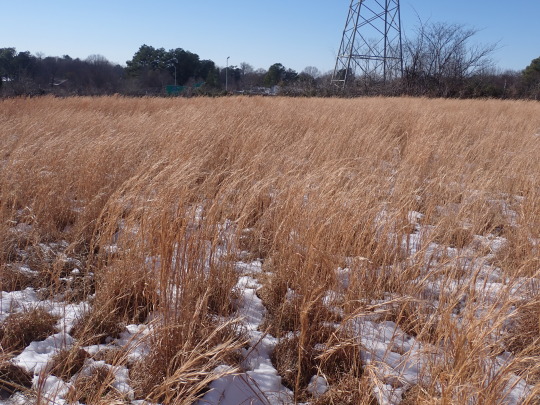
The view from the high grassy field overlooking the way to The Vedge:
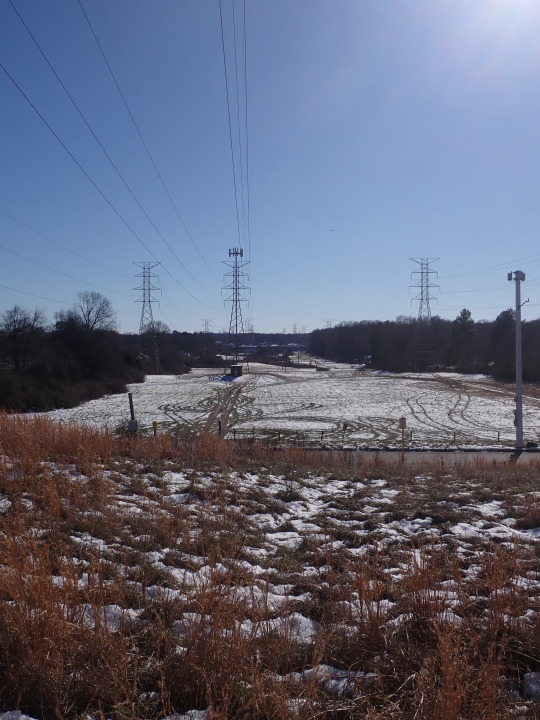
The way to the woods showed signs that the Orcs of the Eye had been there:

The pools were fairly dormant but I did see this fellow swimming about:
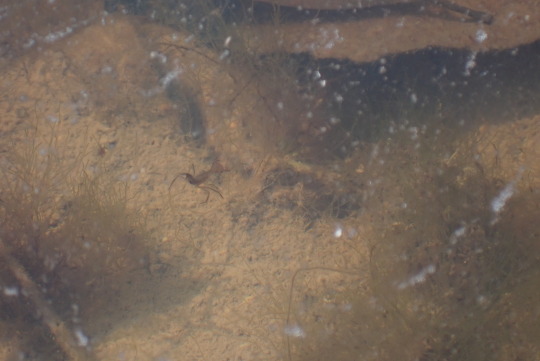
I think it is a damsel fly larva:

I continued to follow the serpentine tracks left by the orcs' foul steeds:
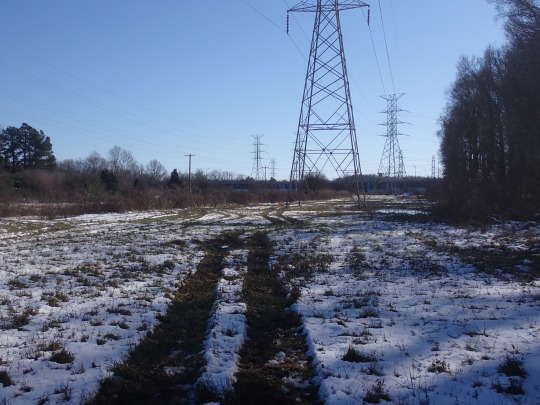

As I suspected, the orcs had laid out bait for the local deer. I "marked" it to warn them off:
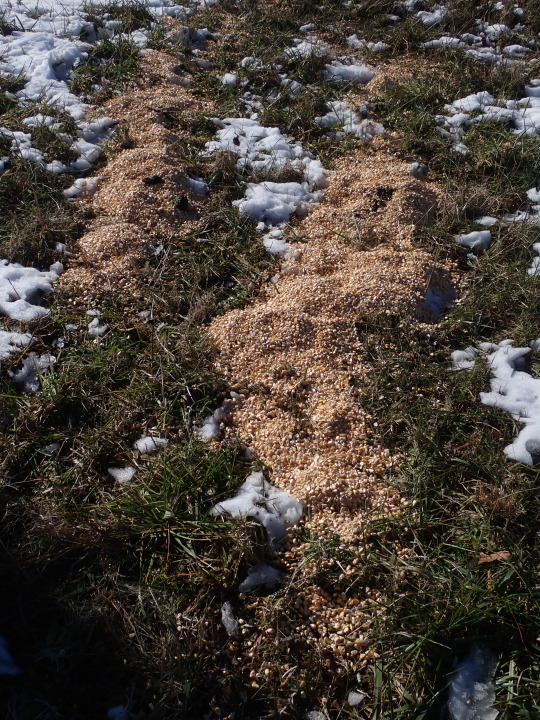
The orcs had built an idol to the Tangerine Tyrant they serve but the forces of nature had already saved me the trouble of toppling it:

Into the woods:

Downtown Dagobah on ice:
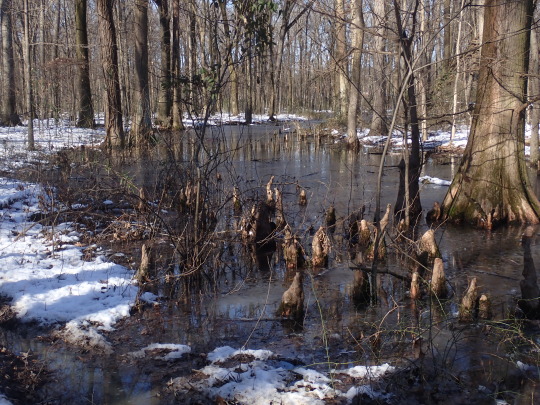
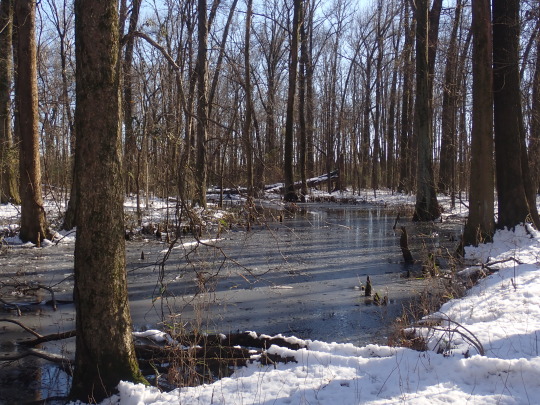

Old great blue heron nests from 2024:

I wonder who uses this little hole access the iced over oxbow:


Crappy pictures of a mystery bird:
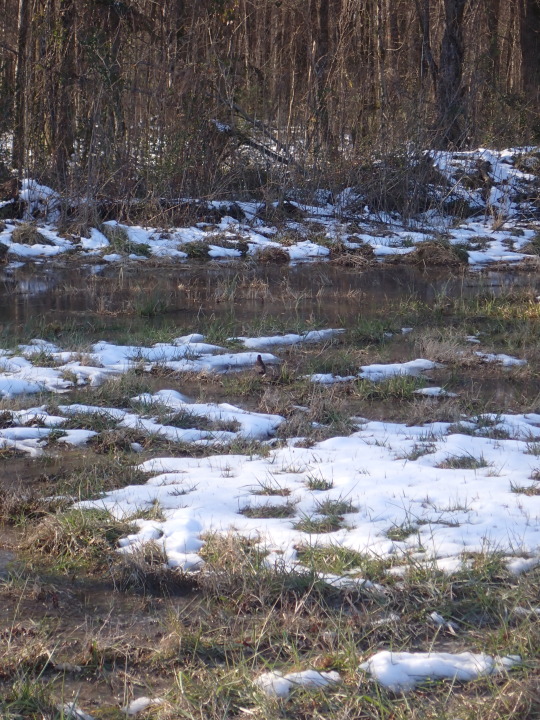
At first I thought it was a female cowbird but its beak was sharp like a robin:

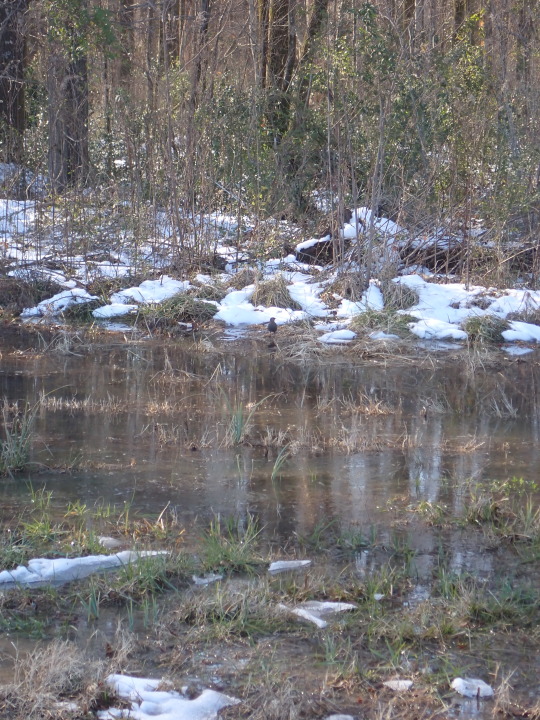
Lost or left here for later:


My lifelong appreciation of drainage ditches continues:

#seen while walking#snowman#mockingbird#field#grass#snow#winter#orcs#orcs of the eye#deer corn#invertebrate#aquatic invertebrate#damselfly larva#tangerine tyrant#hardwood bottomland#downtown dagobah#cypress knees#bird nests#heron nests#oxbow#moss#blue sky#sunlight#mystery bird#bird#tennis ball#dog ball#stacks of bricks#bricks#drainage ditch
6 notes
·
View notes
Text
Skeleton Panda Sea Tunicate Appreciation Post!!! 💀 🐼 🌊



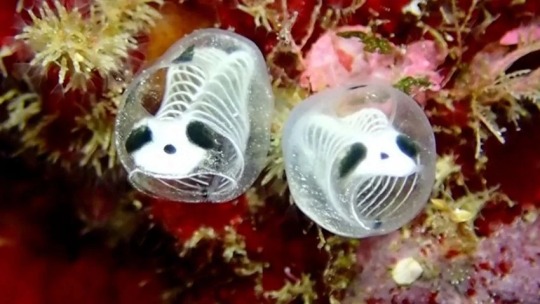


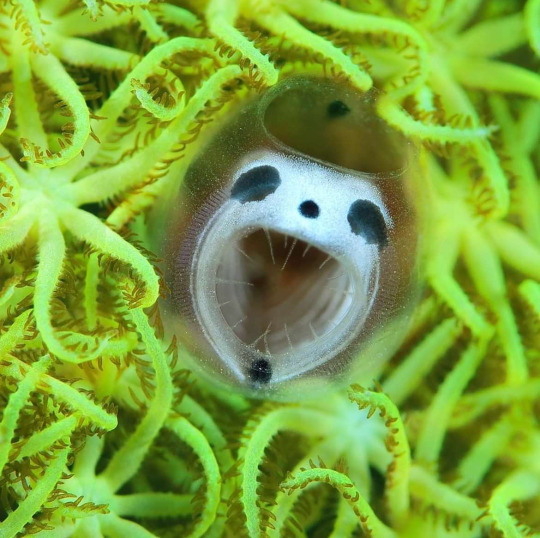
Clavelina ossipandae, the skeleton panda sea tunicate is a species of colonial ascidian, also known as sea tunicates, a group of sessile, marine filter-feeding invertebrates. Just some funky little guys!
First discovered near Kume Island in Japan by local divers, pictures of the animal attracted media attention in 2017. But they weren't given their formal taxonomic description until 2024
Love to sea it 🌊
#marine science#tunicates#science#biology#halloween#spooky season#skeleton#sea creatures#sea critters#marine creatures#marine life#photography#marine biology#sealife#ocean creatures#ocean#oceanposting#love to sea it#aquatic life#marine invertebrates#sea tunicate#chordata#invertebrates#sea life#sea animals#marine animals#ocean animals#ocean critters#fishblr#tunicate
8K notes
·
View notes
Text


Wolf eels enjoying sea urchins
#animal#picture#fish#Anarhichadidae#wolf eel#Ray-finned fish#sea urchin#echinoderm#invertebrate#aquatic animal#aquatic#live animal#animals hunting#face
817 notes
·
View notes
Note
Hiii!
I'm like a week new to Tumblr- I can't figure out how to sort through content well, so you've probably posted about this before
What do you know about sea slugs?? Like particularly interesting ones! I love them and wanna hear your description!!



Here are some of my past nudibranch posts: x x x
One of my favorite nudibranchs is the Sap-sucking sea slug (Cyerce elegans)!


The large leaf-looking parts are known as cerata and help the nudibranch "breathe". They can also be released to use as a distraction if the animal feels threatened!
The species has many color variations, from nearly transparent to red or brown! The color is dependent on the environment in which the species is found; these nudibranchs have coloration that matches the local algae that they eat. This helps them stay camouflaged while they're eating!
#marine biology#marine ecology#animals#science#biology#animal facts#wildlife#marine life#ocean#fun facts#nudibranchs#nudibranch#sea slug#sea slugs#sap sucking sea slug#cyerce elegans#ichthyology#invertebrates#sea creatures#sea animals#aquatic life#marine animals#sea life#ecology#cool animals
355 notes
·
View notes
Text
Wet Beast Wednesday: true water bugs
A while back, I made a Wet Beast Wednesday post about aquatic insect larvae. In that post, I said I'd do another one on aquatic adult insects. Well the time has come, but there are too many aquatic insects to do a whole post about. Instead I decided to cover one group of them, the true water bugs of the clade Nepomorpha. These are all members of the true bug order Hemiptera notable for their aquatic lifestyles, though some spend much of their time on shore and a few species can even fly. Like the larvae post, I'll split this up into brief overviews of some notable groups.
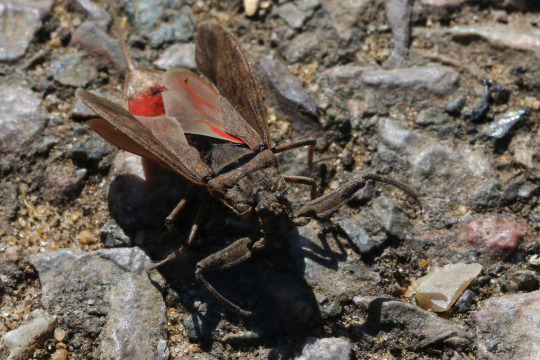
(Image: the water scorpion Nepa Cinerea in a threat posture. It is a large, brown, beetle-like insect. The front pair of legs are developed into mantis-like grasping limbs. The wings are spread, revealing a red abdomen. A tube-like tail extends from the rear end. End ID)
Probably the most famous of the Nepomorpha are the giant water bugs of family Belostomatidae. Also known as toe-biters, alligator ticks, and electric light bugs, these bugs are know for their extremely painful bites. Like other Nepomorphs, their mouthparts are fused into a proboscis which they use to pierce the hides of their prey. They then releases digestive venom into the prey, causing its insides to liquefy for the bug to suck back up. The bites of giant water bugs are described as being excruciatingly painful, but are not medically significant. Giant water bugs look similar to beetles, but their front pair of legs are modified into grasping claws that are used to grab prey and hold it still. In insects, grasping limbs like this are called raptorial. They are primarily ambush predators and their prey includes other invertebrates as well as small fish and amphibians. The largest species are in the genus Lethocerus, which are large enough to hunt young turtles and snakes. The largest can reach over 12 cm (4.7 in), making them the largest of the true bugs. Members of Lethocerus are also powerful flyers known to congregate around electric lights during mating season. After mating, the female lays her eggs on the male's back. He will protect them until they hatch, though he is rendered flightless during this period and cannot mate again until they hatch. Females will mate many times each season. The species Lethocerus indicus is often eaten fried in southeast Asia.
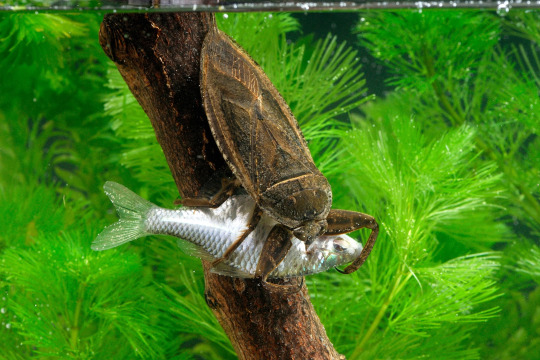
(Image: a giant water bug standing on a stick just below the surface of the water. It is a large, brown, beetle-like bug with a distinct head and large eyes. The front legs are adapted into grasping claws. It has grabbed a small, silvery fish and is feeding on it. End ID)
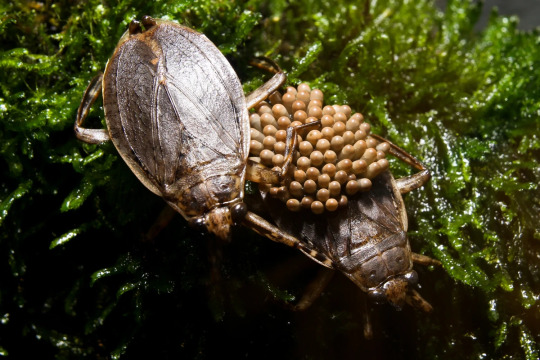
(Image: a female and male giant water bug having recently mated. They are visually similar, but the male is carrying eggs on his back. They are light brown, oval structures laid in a large cluster. End ID)
Similar in appearance and lifestyle to the giant water bugs are the much smaller creeping water bugs of family Naucoridae. While their lifestyle as sit-and-wait predators who use raptorial front legs to catch prey and a proboscis to inject digestive venom is very similar to that of the giant water bugs, they max out in size at about 1.3 cm (1/2 in). Despite being much smaller than giant water bugs, their bites are reported to be far more painful, among the most painful of insect bites, though still not medically serious. They trap bubbles of air beneath their wings to bring an air supply with them as they dive.
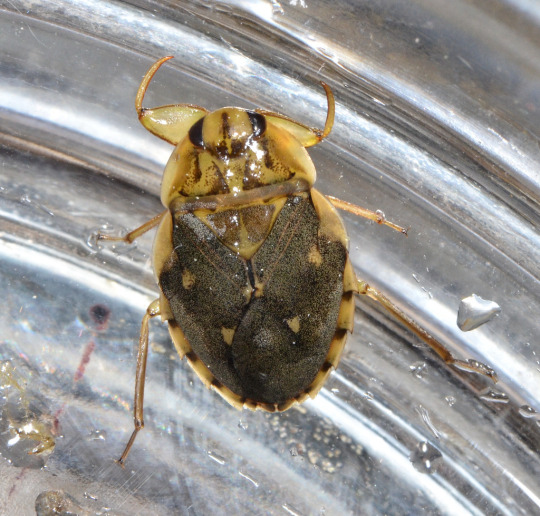
(Image: a creeping water bug. It resembles a giant water bug but with shorter limbs and a less distinct head. Its body is yellowish with darker brown patched and dark wings folded over its body. End ID)
Water scorpions are members of the family Nepidae. All true water bugs have a tube-like structure on their rear ends called the siphon that is used to intake air from the surface of the water. The Nepinae have siphons that are much longer than those of other true water bugs which, combined with their raptorial front limbs, has given them the nickname water scorpions. The water scorpions are divided into two subfamilies, Nepinae and Ranatrinae. The Nepinae have rounded bodies that make them look very similar to giant water bugs while the more common Ranatrinae have slender, elongated bodies that make them look more like stick insects. Water scorpions lay their eggs in mud of vegetation near the water line and prefer slow moving or still water habitats. The family is highly adaptable and has species adapted to hypersaline salt lakes and brackish waters as well as an eyeless, cave-dwelling species found in hypoxic water in Movile cave, Romania. Water scorpions are predators that target invertebrates, tadpoles, and small fish. Their bites are painful to humans, but not dangerous.
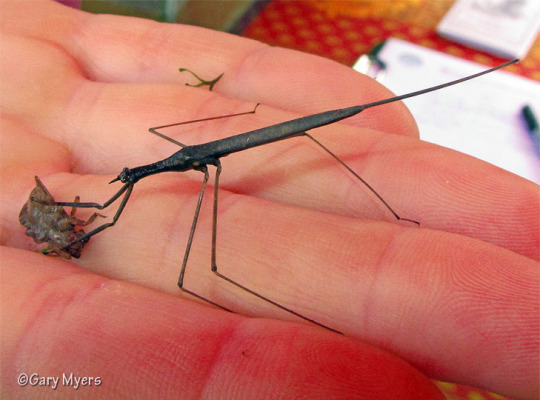
(Image: a Ranatrinid water scorpion held on someone's hand. It is a very long, skinny insect with long, slender legs and forelimbs adapted into raptorial claws. A long-strait tail almost as long as the body emerged from its back. Its grabbing limbs are interacting with another, smaller insect. End ID)
Some true water bugs with a disputed taxonomy are the backswimmers, pygmy backswimmers, and Helotrephids. Typically, backswimmers are placed in the family Notonectidae while the other two are in the family Pleoidea, but some taxonomists argue they should all be in the same family. Backswimmers and pygmy backswimmers have similar body plans and lifestyles, with size being the main difference between them. Both are beetle-like bugs that swim with their bellies facing up. The hind pair of legs is longer than the first two pairs and hairy, allowing them to be used as paddles when swimming. Unlike many other water bugs, which primarily crawl around their habitats and act as ambush predators, backswimmers are powerful swimmers who actively hunt prey as large as tadpoles and small fish. Their front limbs are raptorial and they are capable of flight. Pygmy backswimmers similarly swim upside down and hunt prey, tiny invertebrates in their case. Both groups also have a soft part on their abdomens they use to store air bubbles, which can be refreshed by a trip to the surface. Helotrephids are a sister group to the pygmy backswimmers and are less adapted to swimming, instead crawling for most of the time. Backswimmers can deliver a painful but non-dangerous bite to humans while both pygmy backswimmers and Helotrephids are too small to pierce human skin with their proboscises.

(Image: a backswimmer using surface tension to cling to the surface of the water. It is an insect whose back legs are much longer than the others and have hairy, paddle-like tips used for swimming. It is light brown and has large eyes. end ID)
Similar in appearance to backswimmers are the water boatmen and pygmy water boatmen of families Corixidae and Micronectidae (pygmy water boatmen were formerly classified as also being in Corixidae). The easiest way to tell water boatmen and backswimmers apart is to look at their posture while swimming. While backswimmers swim belly-up, water boatmen swim belly-down. Their four back limbs are long and end in scoop-like tarsi that act as paddles while the forelimbs are shorter and hairier and used for swimming instead of the raptorial forelimbs that backswimmers have. Like backswimmers, water boatmen are powerful swimmers that hunt prey. Unlike all other true water bugs, not all water boatmen are predatory. there are omnivorous, detritovorous, and even entirely herbivorous species that feed on algae and aquatic plants. Note that in some places, water boatmen are known as lesser water boatmen while backswimmers are called greater water boatmen.

(Image: a water boatman clinging to a green fiber. It is a beetle-like bug with long, hairy back legs and shorter front legs. Its body is brown, with numerous small, yellow stripes along the back. End ID)
Two closely related families of true water bugs that live along the shore rather than in water are the toad bugs of Gelastocoridae and the velvety shore bugs of Ochteridae. Both are named for their appearance, with toad bugs being warty and capable of jumping while the velvet shore bugs are known for the extremely fin hairs some species have that helps keep them dry. Toad bugs are predators of other insects who leap onto prey and hold it down with their raptorial front legs. Velvety shore bugs are believed to hunt similarly and can fly.

(Image: a toad bug held on the tip of someone's finger. It is a small, beetle-like bug with a lumpy back and head and short, grasping forelegs. End ID)
The last well-known of the true water bugs are the closely-related families Aphelocheiridae and Potamocoridae, about which almost nothing is known.

(Image: a member of Aphelocheiridae, a small, beetle-like bug with grasping front legs. End ID)
True water bugs are a very successful group, living in freshwater and (in some species) brackish water all over the world, with only the poles being too cold for them. If you spend enough time around fresh water, you will probably see one eventually. If you do, take a look, but don't touch. You never know which ones can give you a very painful bite.

(Image: a giant water bug with its wings extended, standing on grass. End ID)
#wet beast wednesday#aquatic insects#water bug#giant water bug#water scorpion#creeping water bug#backswimmer#water boatman#water boatmen#toad bug#velvety shore bug#true bugs#hemiptera#insects#bug#bugs#bugblr#invertebrates#invertiblr#arthropods#freshwater ecology#biology#ecology#zoology#entomology#educational#informative#image described
85 notes
·
View notes
Text

InsertAnInvert
Motion: Diver 🤘🦠🪰
grousewinged backswimmer (notonecta undulata)
#art#digital art#invertebrate#invertebrates#invert#halftone#screentone#illustration#nature#animals#InsertAnInvert#InsertAnInvert2024#blue#cyan#noAI#sea#animal art#old art#insect#bug#grousewinged backswimmer#backswimmer#aquatic#aquatic animals#water#notonecta undulata
80 notes
·
View notes
Text
Aquele amigo que não descola de você
#tartaruga#turtle#animal#animais#animals#biologia#biology#invertebrates#invertebrados#polvo#octopus#sea#ocean#marine life#aquatic#sea creatures#animais marinhos
71 notes
·
View notes
Text

Look at all those suckers!!! It's so beautiful 😍 I love octopi!! ❤️ you could say that I'm a sucker for them! 😉😁🤣😍
#seattle aquarium#octopus#suckers#tentacles#gorgeous#beautiful#aquatic creatures#cephalopod#invertebrates#animals#lovely#i love the aquarium#love#happiness#thank you#sharing#joy#spectacular#phenomenal#happy
26 notes
·
View notes
Text
I wanted to simulate a slow-moving river or pond from the Amazon, so I used species I have that are found in South and Central America. The substrate is Fluval Stratum, then play sand, then aquarium gravel and aquarium-safe crystals. The hardscape is driftwood and dragon stone. Underwater, there are two scarlet temple plants. Sticking out of the top are a young peace lily and a cutting from a pachira aquatica (money tree). The only animals (barring microfauna) are bladder snails. I have ordered some more South American plants (Amazon frogbit, red root floaters, and Christmas moss), and I hope to introduce some, or possibly all, of those to the tank once they arrive.
23 notes
·
View notes
Text



Little guys came in the post yesterday!
I love shrimp <3
#shrimp#cherry shrimp#aquatic#invertebrates#invertiblr#they’re just little guys and I love them so dearly
11 notes
·
View notes
Text



some of the inverts in my 15 gallon aquarium!
i currently have five cherry shrimp (which i got on saturday) and an unknown amount of bladder snails (which were on one of the plants i bought sometime in december). there's also a ton of detritus worms, but i can't get a good picture of them.
the tank will eventually also be home to a betta as well, but that won't be for a while (i'm going to let the other organisms fully establish themselves first)
#fishblr#inverts#invertiblr#aquarium#shrimp#pet shrimp#aquatic snails#aquatic invertebrates#invertebrates#snail
9 notes
·
View notes
Text

Enough said
#invertebrates#aquatic entomology#aquatic biology#bugs#tw bugs#belostomatidae#family: belostomatidae#giant water bug#icthyology#entomology art#entomology#aquatics
11 notes
·
View notes
Text

Yellow tube sponge (Aplysina fistularis)
Photo by Alex Mustard
#yellow tube sponge#tube sponge#sponge#aplysina#aplysina fistularis#verongiida#sea sponge#yellow#aquatic#marine#marine life#sea#ocean#coral reef#reef#marine invertebrates#marine animals#nature
189 notes
·
View notes
Text

White Lobster
#animal#picture#invertebrate#lobster#Nephropidae#Crustacean#live animal#aquatic#aquatic animal#decapod
42 notes
·
View notes
Text









stimboard for : a sea angel without specification
x | x | x x | x | x x | x | x

#💫stim#💫for you#💫blue line | queue!#sea angel kin#sea creature kin#seakin#sea kin#aquatic kin#aquatickin#oceankin#ocean kin#snailkin#snail kin#sea snail kin#seasnailkin#gymnosomata kin#gymnosomatakin#invertebrate kin#invertebratekin#kin stim#kin request#kin help#animalkin#animal kin#kin stuff
76 notes
·
View notes